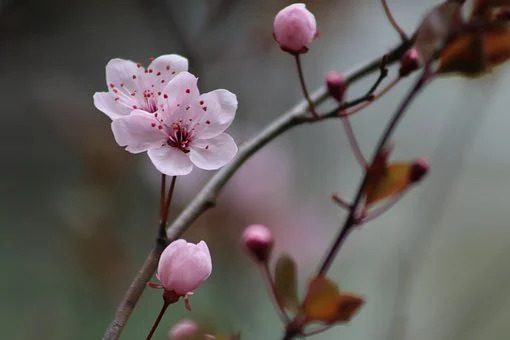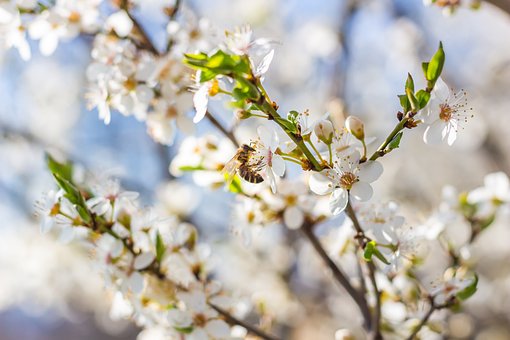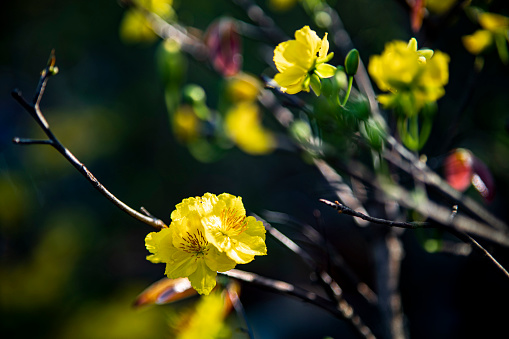
Last updated on May 21st, 2023 at 11:41 pm
Plum flowers are beautiful, pale pinkish flowers that are found in the Asian continent. Plum flowers or Plum blossoms are flowers of the Prunus mume tree species. These blossoms are common in the East Asian countries of China, Japan, Korea, and the Southeast Asian country of Vietnam.
As a result, these flowers are also known as Chinese Plum, Japanese Plum, and Japanese Apricot. Plum Blossoms are an integral part of the cultures of these countries. They are often subjects of art and literature. Plum blossoms are also part of traditional cuisine and medicine.
The Prunus mume species originated on the banks of the Yangtze River in China over three thousand years ago and has been part of Chinese culture for centuries. They were later introduced to the countries of Japan, Korea, and Vietnam from China.
The plum flowers bloom during the mid-winter months and are seen till the early spring months, typically till late February. Plum flowers have a strong fragrance. They come in various shades of white, pink, and red. Different names in these countries know these flowers. In China, they are called Meihua; in Japan, they are called Ume; in Korea, Maesil.
The scientific name of Prunus mume was given by German botanist Philipp Franz von Siebold in 1828. He brought the species from Japan to Holland in 1841 and later brought it to The United States of America in the late nineteenth and early twentieth centuries.
In the 1920s, Walter Bosworth Clarke, a Californian nursery owner specializing in ornamental trees and shrubs, introduced several varieties of these blossoms to the United States of America.
Today Prunus mume has over 300 varieties, of which most are Chinese, and some are Japanese. The Chinese varieties include Zhizhimei Lei, Jiangmei Xing, and Gongfen Xing, while the Japanese varieties include yabai, hibai, and bungo. These varieties are identified based on the form and color of the flowers.
What does the Plum flower symbolize?
Plum flowers are beautiful, ornamental flowers that are part of the gardens of east Asian countries. These flowers that bloom during the bleak, snowy winter months are like a ray of hope, reminding us that spring is coming soon.
The plum flower’s meaning and symbolism are mainly derived from the flowers’ blooming habitat. Plum flowers bloom during the late winter months and early spring months. They are part of two seasons. Therefore, the plum flowers’ meaning closely relates to perseverance and hope.
Plum flowers’ meaning is deeply rooted in Chinese and Japanese cultural history. Since they proclaim the coming of spring and the flowers bloom beautifully in the winter months, they are symbols of perseverance. The plum flowers also mean hope, as the flowers provide us with hope for a new year. On the same note, the plum flowers’ meaning is also related to wealth, joy, health, purity, and renewal.
In Chinese culture, plum blossoms are very important. For them, the five petals of the plum flowers mean the Five Blessings of old age, wealth, health, love of virtue, and natural death.
In Japanese culture, plum flowers are considered to ward off evil. So they are planted in every household to prevent evil from entering the houses. In Japan, plum flowers are associated with vitality, hope, and renewal.
All in all, the plum flower symbolic meanings are:
- hope
- resilience
- perseverance
- courage
- endurance
- vitality
- renewal
Meaning of the Plum flower colors
White color

White plum flowers are a common plum flower variety found in China, Japan, Korea, and Vietnam. The white plum flower is associated with purity.
Pink color

The pink plum flower variety is the most common variety of plum flowers found in these regions. The color pink has a meaning that is related to that love and attraction. Therefore, the pink plum flowers are closely related to affection and love.
Yellow color

Yellow-colored varieties of plum flowers are less common compared to pink and white-colored plum flowers. Yellow flowers symbolize joy, the same with yellow-colored plum flowers.
Red color

The red-colored plum flowers are mostly flowers with a dark pinkish to-red color. The red color in Chinese culture is a symbol of prosperity and wealth. The red-colored plum flowers’ meaning is closely associated with wealth and prosperity.
Interesting facts about the Plum flowers
- The plum is the national flower of the People’s Republic of China.
- The oldest plum tree still flowers is in Huangmei county in Hubei province. The tree is 1,600 years old and dates back to the Jin Dynasty.
- Plum flowers, as well as their fruits, were used in ancient Chinese medicine.
- In China, the plum flowers were most popular during the Tang dynasty.
- In ancient China, women used forehead markings in the shape of plum flowers as part of their makeup.
- In Chinese culture, the plum flowers are considered part of the four noble plants, along with orchid, bamboo, and chrysanthemum.
- Plum blossom flowers are edible and are used in East Asian cuisines. In Korea, plum flowers are used to make tea.
How to grow Plum flowers
Plum trees require less maintenance once planted and have a long lifetime, making them a great addition to your garden.
- Plant the plums in loamy, moist, well-draining soil with an acidic to neutral pH.
- Choose a spot with full sun where they can get six to eight hours of sunlight daily.
- Water the young trees heavily every week during the first growing season to help promote growth.
- Feed young trees with a high-nitrogen fertilizer when they have set a crop.
- Keep the area under the tree free of weeds and tall grass, especially around the trunk.
How to care for Plum flowers
- Provide extra watering during long stretches without rainfall or in the extreme summer heat.
- Apply all-purpose fertilizer annually in the spring as new growth begins. Only fertilize every two to three years if the soil is rich and fertile.
- Prune freely for shape immediately after blooming to induce vigorous new growth.
- Remove dead, damaged, or crossing branches at the base.
Best time to gift Plum flowers
Plum flowers have many good symbolic implications in that they are appropriate gifts for almost any happy or joyous event.
These flowers are excellent gifts to wish a friend, loved one, or coworker success and wealth in a new venture or convey optimism and courage.
They can also be used to recognize someone’s fortitude and capacity to persevere in the face of adversity, just as the plum flower overcomes the winter cold to bloom.
Conclusion
Plum trees are ornamental trees that are grown in most households. Their beauty has inspired many great works of art, including paintings and poems. The view of plum flowers in full bloom during the harsh winter months calms people’s minds and souls.
Therefore, many people in East Asian countries spend time watching plum blossoms and having picnics under the trees. They also bring hope and joy to the people as the plum flowers’ meaning is associated with that purity, revival, hope, vitality, and perseverance.
If you want to know and learn more about flowers, we at PansyMaiden can help you. Check out our fun, easy-to-read, and informative flower-related content that you will surely enjoy!

